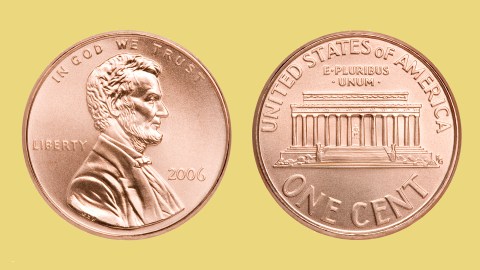There Are $39 Million Reasons to Stop Making the Penny

According to the US Mint, the cost of making a penny in 2015 was 1.4 cents. These cents add up to millions of wasted dollars every year, and in 2015 alone, its production cost taxpayers $39 million. Meanwhile, even my local vending machines won’t accept them for the cent that they’re supposedly worth. Given how hard it is to spend a penny and that the raw materials are worth more intrinsically than pennies themselves, it’s hard to see why the government bothers to continue making them. As Binyamin Appelbaum points out in The New York Times, if the purpose of currency is to facilitate commerce, the penny is clearly failing.
An America without pennies is actually not hard to imagine. All prices and transactions would be in increments of $0.05. And while we’re at it, we may well consider rounding everything to tenths of a dollar (i.e., making dimes the new pennies) because, at 7.4 cents a pop, nickels aren’t cost-effective either. More concretely, America would not be the first country to abolish the penny. Canada, where coins are similarly costly to produce, stopped manufacturing and started recycling pennies a few years ago.
Nevertheless, some remain steadfast in their endorsement of the cent. But if citizens can barely use pennies and the government is spending millions to make them, then who is left to take a protectionist stance against the copper-coated coin? Nostalgia-laden penny-lovers aside, one staunch defender of token is Brian Domitrovic, a contributor of Forbes who wrote a daring defense of the dollar’s hundredth. He argues that in an economy running on faith in fiat currency, the pennies and nickels are the closest things America has to its banking system having a firm foundation. Historically, he observes, such a system is what Americans have preferred. He writes:
The gold piece was $20, because that was the smallest you could get a stamped disk of gold worth a reasonable amount and still see it. Silver traded about 1/20th of gold on the markets, so a similarly sized piece in silver became the dollar. Nickel was worth less than silver as much as silver was worth less than gold, so it came in for the 5-cent piece. Copper traded at a fifth of nickel, so it got tabbed for the penny.
Note the relationship between the monetary unit and the metallic constituent of the unit. The monetary unit was worth just a little more than the underlying metal. If you boiled a gold dollar into liquid (an old French word for boiling was bouillion), you would get a shade less than $20 in gold, and the same thing in turn for all the other units. Bullion was cumbersome as a means of exchange, but reliably stamped common units of bullion were not.
While the historical narrative is insightful, it’s hard to imagine pennies as anything but cumbersome, especially when cashiers and impatient customers nationwide roll their eyes when a surprisingly patient person proceeds to use them. Furthermore, looking more into American monetary history, we find that the half-cent coin was abolished when it was valued at a whole eight cents of today’s currency.
Domitrovic’s defense of the penny is more than merely a historical argument, however. He adds that it is our last remaining means for keeping the banking system accountable. Reflecting on our present economic climate, he writes:
The Federal Reserve has bought out bond-holders to the tune of $40 billion a month for the long term, stacked up “excess reserves” in the accounts of its numerous money-center member banks, lowered interest rates to the zero-bound, and blown off standard market measures of the judiciousness of its easing (as in the 400%-600% run-up in gold this millennium).
All that, again, for the worst recovery since the Great Depression, if not ever.
Thus what we have with the penny and the nickel is the last, residual restraint that the government actually faces when it manufactures money. This money, this petty change, actually costs something to make. Which would be precisely why we should insist that the United States keep making it.
His historic narrative of the penny is compelling, but it might be a stretch to imagine that pennies and nickels are sufficient to constrain the modern banking system from running astray with inflation in the face of the Federal Reserves monthly allowance of $40 billion to bond-holders.
In the face of all this penny-madness, the concise prescription of Harvard economist Greg Mankiw provides sober insight:
[The] New York Times reports: “it costs the mint well more than a cent to make a penny.” The solution, in my view, is to get rid of the penny.





